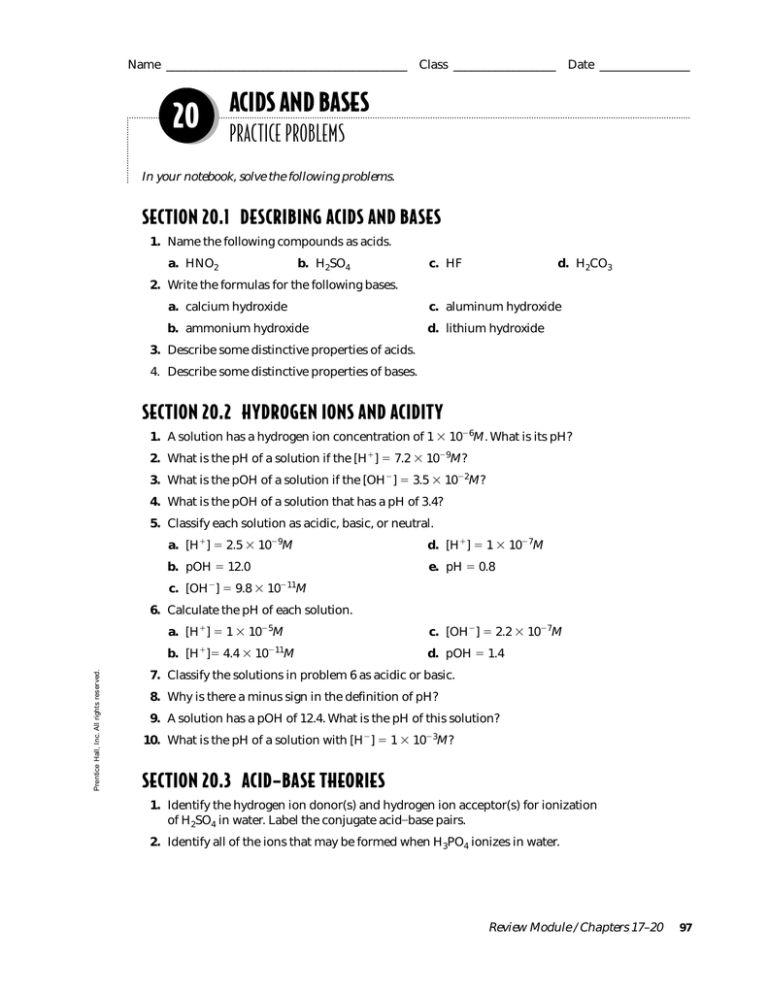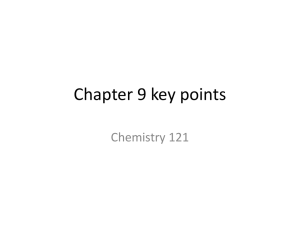
Name ________________________________________ Class _________________ Date _______________
20
ACIDS AND BASES
PRACTICE PROBLEMS
In your notebook, solve the following problems.
SECTION 20.1 DESCRIBING ACIDS AND BASES
1. Name the following compounds as acids.
a. HNO2
b. H2SO4
c. HF
d. H2CO3
2. Write the formulas for the following bases.
a. calcium hydroxide
c. aluminum hydroxide
b. ammonium hydroxide
d. lithium hydroxide
3. Describe some distinctive properties of acids.
4. Describe some distinctive properties of bases.
SECTION 20.2 HYDROGEN IONS AND ACIDITY
1. A solution has a hydrogen ion concentration of 1 3 1026M. What is its pH?
2. What is the pH of a solution if the [H1] 5 7.2 3 1029M?
3. What is the pOH of a solution if the [OH2] 5 3.5 3 1022M?
4. What is the pOH of a solution that has a pH of 3.4?
5. Classify each solution as acidic, basic, or neutral.
a. [H1] 5 2.5 3 1029M
d. [H1] 5 1 3 1027M
b. pOH 5 12.0
e. pH 5 0.8
c. [OH2] 5 9.8 3 10211M
Prentice Hall, Inc. All rights reserved.
6. Calculate the pH of each solution.
a. [H1] 5 1 3 1025M
c. [OH2] 5 2.2 3 1027M
b. [H1]5 4.4 3 10211M
d. pOH 5 1.4
7. Classify the solutions in problem 6 as acidic or basic.
8. Why is there a minus sign in the definition of pH?
9. A solution has a pOH of 12.4. What is the pH of this solution?
10. What is the pH of a solution with [H2] 5 1 3 1023M?
SECTION 20.3 ACID–BASE THEORIES
1. Identify the hydrogen ion donor(s) and hydrogen ion acceptor(s) for ionization
of H2SO4 in water. Label the conjugate acid]base pairs.
2. Identify all of the ions that may be formed when H3PO4 ionizes in water.
Review Module / Chapters 17–20
97
Name ________________________________________ Class _________________ Date _______________
3. Classify the following acids as monoprotic, diprotic or triprotic.
a. HCOOH
b. HBr
c. H2SO3
d. H3ClO4
4. What would you expect to happen when lithium metal is added to water? Show the
chemical reaction.
5. In the following chemical reaction, identify the Lewis acid and base.
BF3 1 F2 1 BF42
SECTION 20.4 STRENGTHS OF ACIDS AND BASES
1. Rank 1M of these compounds in order of increasing hydrogen ion
concentration: weak acid, strong acid, strong base, weak base.
2. Write the expression for the acid dissociation constant of the strong acid
hydrofluoric acid, HF.
3. Write the expression for the base dissociation constant for hydrazine, N2H4, a
weak base. Hydrazine reacts with water to form the N2H51 ion.
4. Use Table 20.8 in your text to rank these acids from weakest to strongest:
HOOCCOOH, HCO32, H2PO42, HCOOH.
5. Write the equilibrium equation and the acid dissociation constant for the
following weak acids:
a. H2S
b. NH41
c. C6H5COOH
6. Match each solution with its correct description.
a. dilute, weak acid
(1) 18M H2SO4(aq)
b. dilute, strong base
(2) 0.5M NaOH(aq)
c. concentrated, strong acid
(3) 15M NH3(aq)
d. dilute, strong acid
(4) 0.1M HC2H3O2(aq)
e. concentrated, weak base
(5) 0.1M HCl(aq)
8. A 0.10M solution of formic acid has an equilibrium [H1] 5 4.2 3 1023M.
HCOOH(aq) → H1(aq) 1 HCOO2(aq)
What is the Ka of formic acid?
9. The Ka of benzoic acid, C6H5COOH, is 6.3 3 1025. What is the equilibrium [H1]
in a 0.20M solution of benzoic acid?
10. A 0.10M solution of hydrocyanic acid, HCN, has an equilibrium hydrogen ion
concentration of 6.3 3 1026M. What is the Ka of hydrocyanic acid?
98
Review Module / Chapters 17220
Prentice Hall, Inc. All rights reserved.
7. Write the base dissociation constant expression for the weak base analine,
C6H5NH2.
C6H5NH2(aq) 1 H2O(l) 1 C6H5NH31(aq) 1 OH2(aq)







